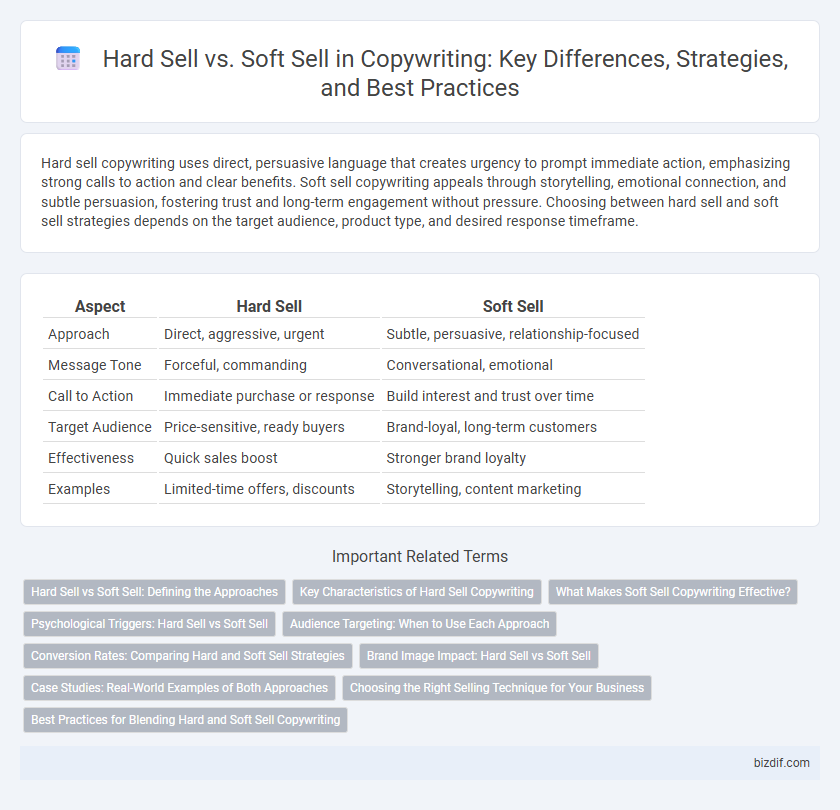Hard sell copywriting uses direct, persuasive language that creates urgency to prompt immediate action, emphasizing strong calls to action and clear benefits. Soft sell copywriting appeals through storytelling, emotional connection, and subtle persuasion, fostering trust and long-term engagement without pressure. Choosing between hard sell and soft sell strategies depends on the target audience, product type, and desired response timeframe.
Table of Comparison
| Aspect | Hard Sell | Soft Sell |
|---|---|---|
| Approach | Direct, aggressive, urgent | Subtle, persuasive, relationship-focused |
| Message Tone | Forceful, commanding | Conversational, emotional |
| Call to Action | Immediate purchase or response | Build interest and trust over time |
| Target Audience | Price-sensitive, ready buyers | Brand-loyal, long-term customers |
| Effectiveness | Quick sales boost | Stronger brand loyalty |
| Examples | Limited-time offers, discounts | Storytelling, content marketing |
Hard Sell vs Soft Sell: Defining the Approaches
Hard sell emphasizes urgent, direct calls to action with clear, concise messaging designed to provoke immediate purchases, typically featuring limited-time offers and strong emotional triggers. Soft sell relies on subtle persuasion through storytelling, brand building, and creating emotional connections, fostering trust over time without overt pressure to buy. Understanding these contrasting approaches enables marketers to tailor strategies based on target audience responsiveness and product type.
Key Characteristics of Hard Sell Copywriting
Hard sell copywriting relies on direct, forceful language designed to prompt immediate action, often using urgent calls to action and limited-time offers. It emphasizes clear benefits, strong guarantees, and persuasive statistics to create a sense of urgency and necessity. This approach targets impulse buyers by appealing to emotions like fear of missing out and encourages quick decision-making.
What Makes Soft Sell Copywriting Effective?
Soft sell copywriting engages consumers by creating emotional connections and building trust through storytelling and relatable messaging. It leverages subtle persuasion techniques and focuses on long-term customer relationships rather than immediate sales. This approach increases brand loyalty and encourages decision-making by appealing to the audience's values and needs.
Psychological Triggers: Hard Sell vs Soft Sell
Hard sell copywriting leverages psychological triggers such as urgency, scarcity, and fear of missing out to prompt immediate action from consumers. Soft sell approaches utilize emotional appeal, trust-building, and storytelling to create lasting brand connections and subtle persuasion. Understanding these psychological triggers enables marketers to tailor strategies that either push for quick conversions or foster long-term customer loyalty.
Audience Targeting: When to Use Each Approach
Hard sell techniques work best for time-sensitive offers targeting impulsive buyers who respond to direct, urgent calls to action. Soft sell appeals are ideal for nurturing long-term relationships with informed audiences seeking value and trust before making purchasing decisions. Understanding audience intent and buying stage ensures the effective application of hard sell or soft sell copywriting strategies.
Conversion Rates: Comparing Hard and Soft Sell Strategies
Hard sell copywriting often achieves higher immediate conversion rates by creating urgency and compelling direct action through strong calls-to-action and scarcity tactics. Soft sell strategies build trust and long-term customer relationships by engaging audiences with relatable storytelling and subtle persuasion, which can result in lower immediate conversions but higher lifetime value. Analyzing conversion metrics reveals that blending hard sell urgency with soft sell emotional appeal frequently maximizes overall campaign effectiveness.
Brand Image Impact: Hard Sell vs Soft Sell
Hard sell techniques, characterized by urgent calls to action and aggressive messaging, risk damaging brand image by creating consumer resistance and perceptions of pushiness. Soft sell strategies, employing subtle persuasion and emotional appeal, enhance brand image by building trust and fostering long-term customer relationships. Brands aiming for sustainable loyalty often prefer soft sell to maintain a positive and approachable image.
Case Studies: Real-World Examples of Both Approaches
Case studies reveal that hard sell techniques drive immediate consumer action through urgency and direct calls to action, exemplified by flash sale campaigns in e-commerce that boost short-term conversion rates by up to 30%. Soft sell approaches, demonstrated in brand storytelling campaigns by companies like Apple, foster long-term customer loyalty and higher lifetime value by creating emotional connections and emphasizing product benefits gently. Data from these examples indicates that combining both approaches strategically can optimize overall marketing effectiveness depending on target audience behavior and sales objectives.
Choosing the Right Selling Technique for Your Business
Hard sell techniques use direct, urgent calls to action that create immediate purchase pressure, which suits businesses aiming for quick conversions in competitive markets. Soft sell approaches build trust and emotional connections through storytelling and subtle persuasion, ideal for brands focused on long-term customer loyalty and premium positioning. Analyzing your target audience's preferences, product lifecycle, and sales goals helps determine whether a hard sell or soft sell strategy maximizes revenue and brand equity.
Best Practices for Blending Hard and Soft Sell Copywriting
Blending hard sell and soft sell copywriting enhances conversion by balancing urgency with relationship-building, using persuasive calls-to-action alongside value-driven storytelling. Effective practices include segmenting audiences to tailor messages, incorporating social proof to build trust, and testing tone variations to optimize engagement and response rates. Combining clear, direct offers with emotional appeals ensures the copy resonates deeply while driving immediate action.
Hard Sell vs Soft Sell Infographic

 bizdif.com
bizdif.com